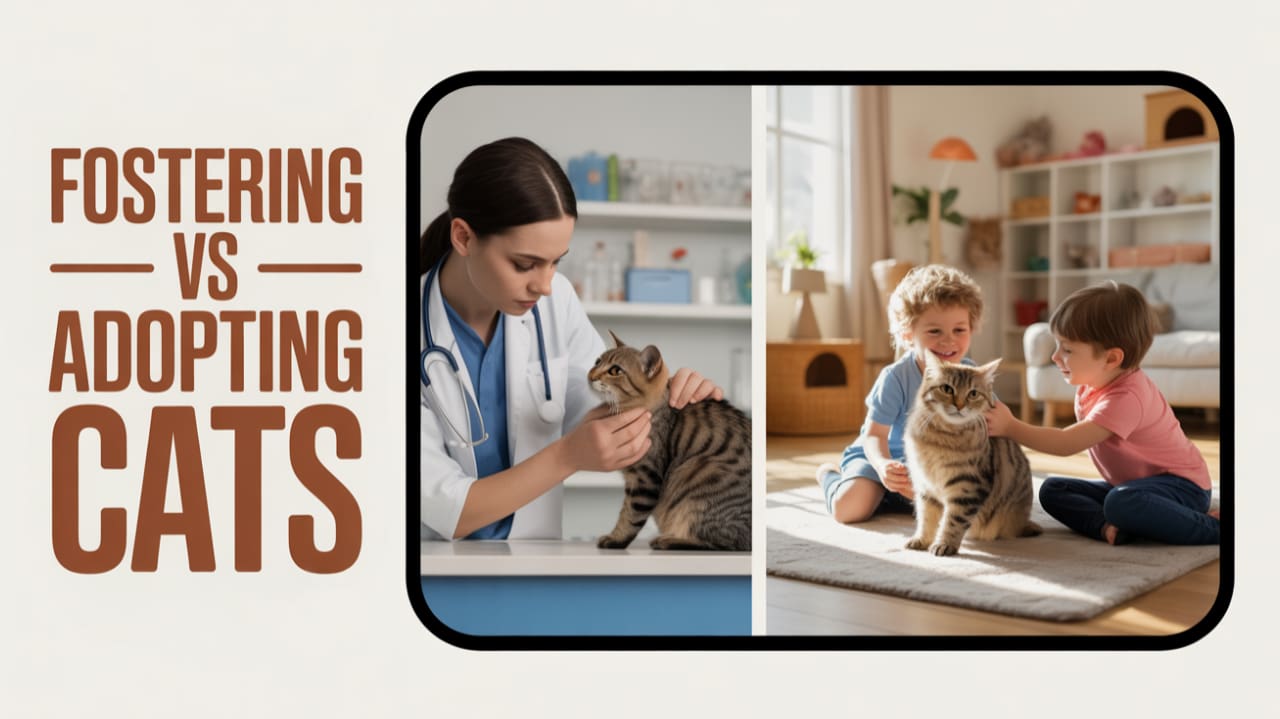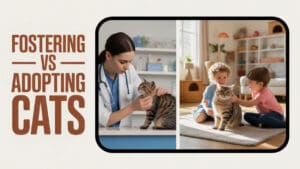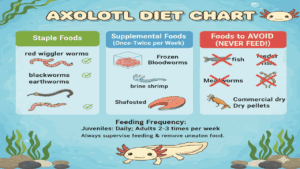Fostering vs Adopting Cats (2025): Costs, Responsibilities, Expert Tips, and Common Mistakes to Avoid
Perhaps you’re thinking of making a difference to the lives of these creatures? They are, after all, just craving warmth and love. But maybe you’re facing this dilemma: fostering vs adopting cats. What’s the difference? And which path should you choose?
Now, opening your home to a cat is noble, and it is quite a big decision. In the most basic sense, fostering is having you provide short-term care to the animal. Adoption, on the other hand, comes with a lifelong responsibility. But you should know that the difference is not only temporary vs permanent.
In terms of cost, for example, you won’t need to worry about your pocket much for fostering because shelters usually cover the cat’s medical expenses. As an adopter, however, you’ll likely need to budget for a yearly cost that can go up to about $600–$1,200.
That said, you shouldn’t think that fostering is always easier. The bittersweetness of saying goodbye to your foster cat can be difficult for some to endure.
Veterinarians say that adopting a cat means that you’ll be providing them with stability. Fostering, however, is for you to help prepare the animal for actual adoption. Your main role in the latter is to ease the feline’s stress and improve their behavior.
Now, let’s take a look at the differences more clearly and see which path is best suited for your lifestyle, budget, and emotional readiness. You’ll see, by the end of this piece, that fostering can save lives and that adoption can transform bonds.
Fostering vs Adopting Cats: What Do They Mean
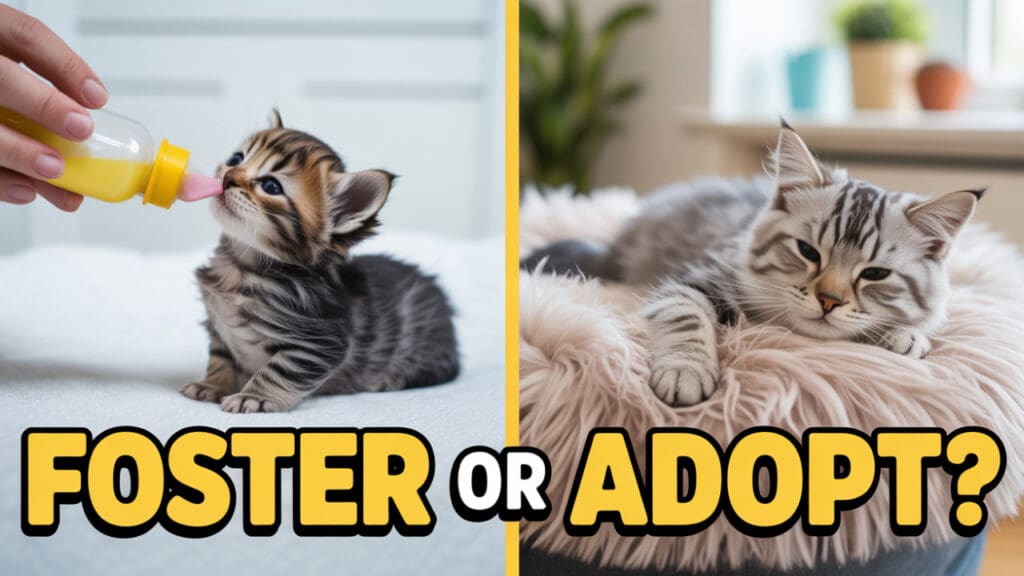
You might have heard the terms being thrown around: fostering vs adopting a cat. They might have sounded similar to most, often almost interchangeable. However, you should know that each of these represents two very different levels of commitment.
When you foster a cat, it means that you’re agreeing to provide them with temporary care in your home. You’ll be responsible for them until they are ready for or find someone who would adopt them, giving the animal a permanent home. This means fostering can take from weeks to months, or even much longer, depending on your cat’s situation.
Now, you should understand that animal shelters cannot provide individualized care thanks to the sheer number of animals they house. That’s why they need foster families to take care of young kittens, cats that are recovering from medical procedures, or animals that are too stressed to live in the crowded shelter environment.
Essentially, know that the goal of fostering is to give the cat stability, love, and basic training until they can find their forever home.
On the other hand, adoption is a lifelong commitment. Think of it as taking in an animal child and making them a permanent family member. With that, your responsibility to them includes vet care, food, shelter, and companionship. And this commitment should last a lifetime.
With adoption, there usually comes an upfront fee. For example, in the U.S., it might cost you somewhere between $50 and $200 to adopt a cat. But you can feel relieved knowing that this often comes with vaccinations, spaying or neutering, and sometimes even microchipping.
Fostering vs Adopting: A Side-by-Side Comparison
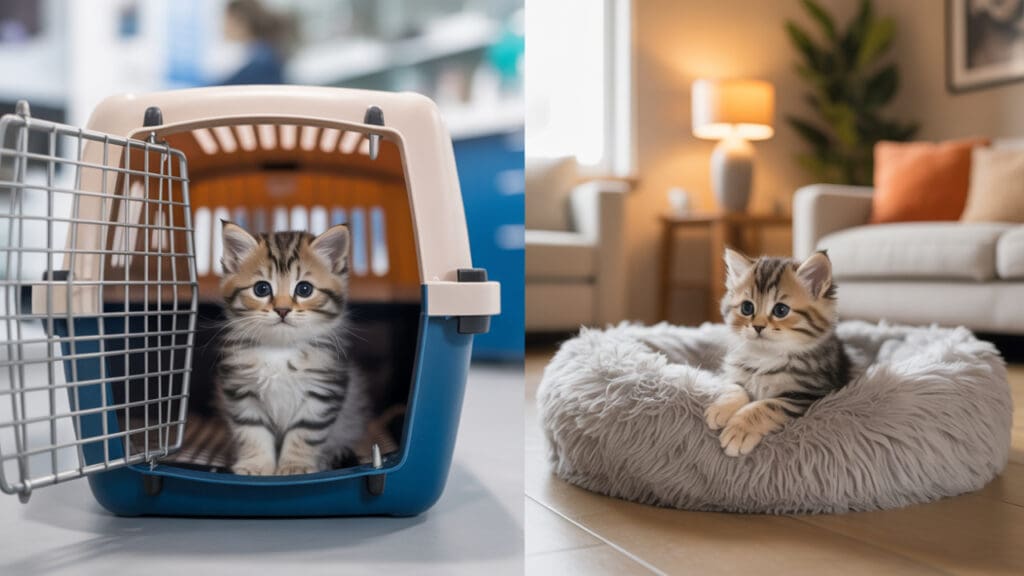
Understanding the key differences between fostering and adopting can help you make an informed decision. Here’s a comprehensive comparison based on current data and expert insights:
| Factor | Fostering | Adopting |
| Commitment | Temporary (2 weeks – 6+ months) | Permanent (12-18 years average lifespan) |
| Primary Goal | Prepare cat for permanent adoption | Provide a forever home |
| Financial Responsibility | Typically covered by shelter (vet, supplies, food) | You are 100% responsible ($600–$2,300+ annually) |
| Decision-Making | Shared with shelter/rescue organization | You have full autonomy |
| Ideal For | Flexible schedules, testing pet ownership, saving lives without long-term commitment | Stable lifestyle, desire for deep permanent bond, readiness for full responsibility |
| Emotional Impact | Meaningful but bittersweet goodbyes | Deep, lasting bond with permanent family member |
| Success Rate | 64% of fostered cats get adopted (2024 data) | 82% overall save rate for shelter cats |
Fostering vs Adopting Cats: Why People Choose to Foster
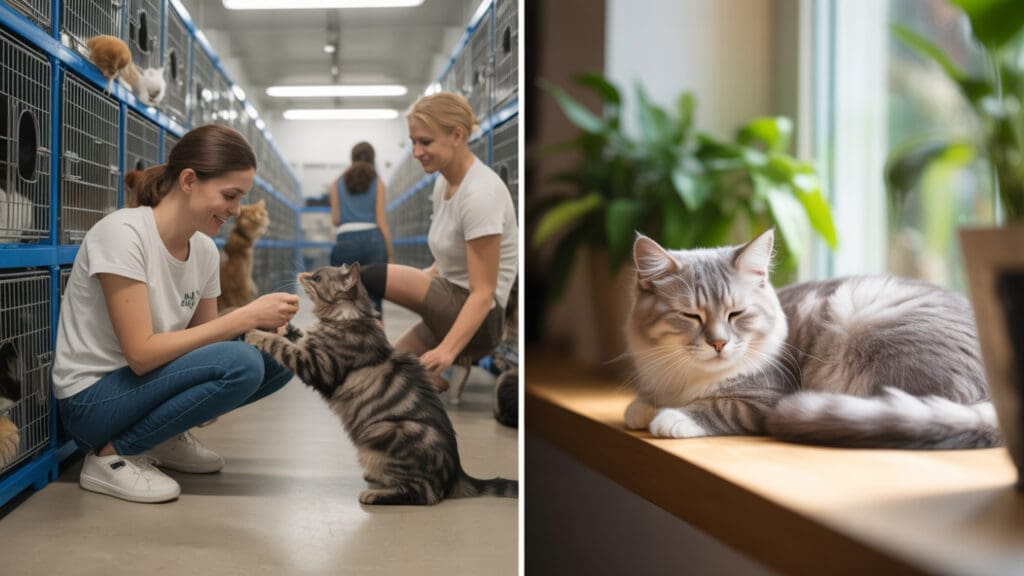
You may be an animal lover and know how rewarding it is to help a cat in need. Perhaps you might have come across the idea of fostering. It’s a unique way to make a difference in the cats’ lives without the lifelong commitment that comes with adoption. But is fostering cats a good idea for you? Let’s find out.
Now, one of the biggest reasons to foster a cat over adoption is flexibility. You should know that fostering means your time spent with the feline is temporary. It can sometimes be just a few weeks. In essence, you’ll only need to care for them until a family is willing to adopt them.
This flexibility appeals to a lot of animal lovers who want companionship but aren’t ready for the 10-15 years of responsibility that follow the alternative option.
The next factor is cost. Know that shelters will usually cover the vet care expenses and sometimes even the animal’s food and supplies. That means you won’t need to fork out too much money on your end. You just need to provide love and space for the cat.
Having said that, you shouldn’t underestimate the emotional cost. Saying goodbye to a cat you’ve taken care of, especially for a long period, can be heavier than you may expect. If you have a child who has bonded with the animal, that makes it hit even harder.
Moving on, another reason people foster animals is because of the impact. As a foster, you can usually give the cat a much calmer environment compared to the shelter. This, then, helps the feline to recover better from injuries, adjust after being abandoned, or even start socializing.
Many shelter coordinators agree, too, saying that cats in foster care do adopt faster because they feel less stressed and better adjusted to home life. This means as a foster parent, you’re playing a direct role in saving lives.
However, try not to take on more than you can chew. These animals are already stressed out to begin with, so housing them in large numbers can make things worse. Experts recommend that we start with just one foster cat to understand what it really takes to take care of them.
Fostering vs Adopting Cats: Why People Choose to Adopt
Now, let’s look at the other side of the coin: adoption. You’re giving the cat a permanent home, not just showing compassion. They are now your cat. Adoption is equivalent to making a lifelong commitment to care, companionship, and stability.
One of the strongest reasons people adopt an animal is because of the bond. When you take that cat home, you two become family, and you will be responsible for every aspect of your feline child’s well-being. They are part of your daily routine. And you’re making sure that your precious pet no longer has to suffer through stress, anxiety, or any pain alone.
This creates a much deeper sense of motivation to care and attachment compared to fostering. After all, at the back of your head, you know that you’ll be cuddling and building memories with your cat pal for years to come.
The next reason closely ties to the first: transformation. If you adopt a cat, the likelihood is that you’ll witness a remarkable change in your feline’s behavior. The once-abandoned or anxious creature that trembled in fear now walks with confidence, showing you affection openly. This journey of healing and trust-building is possibly the most rewarding.
Of course, commitment is central to this decision, and the emotional return can be just as impactful on you. Think, you’re essentially shouldering your cat’s long-term needs for vet visits, a stable diet, and emergency preparedness. This can directly translate to the animal living a longer and healthier life.
If you are an animal lover (which you probably are, seeing that you’re here), you can probably feel how this could far outweigh the money, time, and energy put into taking care of them.
The Unspoken Challenges: A Reality Check from Experts
Fostering and adoption are deeply rewarding, but the real-world experience often differs from expectations. Here’s what experts and professionals want you to know:
From a Shelter Coordinator’s Perspective
“The biggest challenge we see is foster parents not understanding that recovery isn’t always linear. Some cats arrive deeply traumatized and need weeks or months to show their true personality. Foster parents need resilience and strong communication with our team,” explains Eileen Hanavan, Director of Volunteer and Foster Engagement at the ASPCA.
Research shows that 38% of foster volunteers successfully avoid “foster fails,” while another 38% adopt only one or two animals over a decade.
A Veterinary Behaviorist’s Insight on Foster Stress
Contrary to popular belief, cats don’t necessarily experience more stress in foster homes. A study from Oregon State University, published in Animals journal, found that cats in foster placements showed no increase in fear, aggression, or cortisol levels compared to shelter cats.
Takeaway: Foster homes provide emotional stability without raising stress levels.
The Adopter’s Hidden Financial Reality
Adoption fees usually range from $50–$200, but the real costs of cat ownership are much higher:
- Average annual expenses: around $2,300
Common costly conditions:
- Urinary blockages – $2,360
- Diabetes management – $1,575
Affordable pet insurance (starting at $10/month) can help cover emergencies and protect adopters from financial strain.
Key Differences in Responsibilities: Fostering vs Adopting Cats
Now that you know why people choose to foster or adopt a cat, let’s take a look at some key differences in the two’s responsibilities. They can be dramatically different. So, make sure you put some thought into this before opting for either path.
Let’s take a look at possibly the most practical contrast between the two: financial responsibility. You should know that fostering usually means you have the support of the shelter. And as mentioned, they’ll most likely cover the cat’s vet bills and perhaps even provide food or litter.
Adoption, though, means you are transferring that full cost to yourself. As an estimate, you should see an expense of around $760–$3,495 (or even more) per year spent on food, preventative vet care, and emergencies.
The next thing is daily responsibilities. As a foster parent, you’re essentially asked to help take care of the animal for recovery purposes. For instance, you’ll socialize a shy cat, administer medications, or monitor their recovery after a surgery. These are responsibilities to help the cat be fit enough to be taken to another home.
If you adopt an animal, however, your responsibility goes beyond this. You’ll need to provide ongoing enrichment and bond with your pet deeply. Health maintenance for your cat, both physical and emotional, is for a lifetime. So, patience, consistency, and permanence are really important.
The next major difference is decision-making. As a foster, you rely heavily on shelters to provide you with guidance. This can be about medical issues or behavioral ones. You’re more like a partner in the cat’s journey rather than family, in a sense.
As an adopter, on the other hand, you’ll have full independence in making choices regarding your cat’s diet, vet care, and even their end-of-life decisions. Veterinarians say that this independence can be empowering, but it also comes with greater responsibility and accountability.
A Day in the Life: Foster Parent vs. Adopter
Understanding daily responsibilities helps clarify the practical differences between fostering and adoption:
A Day as a Foster Parent (with a Shy Adult Cat):
- 7:00 AM: Quietly enter the designated “cat room.” Clean litter box, refresh food and water without forcing interaction.
- 7:30 AM: Sit on the floor reading or working on laptop, allowing the cat to observe and adjust to your presence at their own pace.
- Evening: Attempt 10-15 minute gentle socialization session. If the cat hides, you respect their boundaries and end the session. Document behavior and progress in foster journal for shelter team.
- Goal for the week: Help the cat feel safe enough to eat while you’re in the room.
A Day as an Adopter (with Your Permanent Cat):
- 7:00 AM: Your cat greets you at the bedroom door, demanding breakfast. You provide their prescribed diet (which you researched and purchased).
- Afternoon: You notice she’s been scratching more than usual. You schedule a vet appointment and will pay the $50–$75 consultation fee.
- Evening: You administer monthly flea prevention ($6–$25 per dose) and plan for her annual vaccination booster ($38–$75).
- Goal for the year: Save $600+ for potential emergency care and maintain her preventive health routine.
Fostering vs Adopting Cats: Can You Adopt a Cat You Foster?
Now, you might have been a foster parent to these animals in need for some time. Or maybe you’re just curious. Perhaps you’re thinking of adopting that foster cat of yours that you’ve really bonded with. Can you do that?
Well, you should feel relieved knowing that the answer is yes. There are a good number of shelters and rescues that actually encourage this. And you might have heard the term for such a case, too. It’s called “foster fail.” Now, let’s not focus on the second word. It’s actually more of a success story in concept.
So, when you foster a cat, you give the feline a home that is temporary. But if the bond you create with the pet becomes really strong, too strong to let go, most organizations actually give you the first opportunity to adopt the cat.
Transitioning to adoption means you’ll need to go through the same procedure that an adopter will need to face. But first, you need to inform the shelter or rescue that you wish to adopt the animal. Then, you’ll need to do the paperwork, an adoption application, basically. Sometimes, there’ll be an interview involved or even a home check, so be ready for that.
Once the adoption is approved, you’ll sign the contract that details your responsibility as an owner. There’s the standard adoption fee, which can be from anywhere between $50 and $200. That depends on the shelter. But now, that used–to-be foster cat is your permanent family member.
A fair warning. Don’t think that you can automatically make the cat yours just because you’re their foster parent. The application process still applies even though you’re given the privilege of being prioritized. And you shouldn’t just do this on an impulse. Consider and budget the expenses first before you really commit to this path.
Fostering vs Adopting Cats: Common Misconceptions
You might have heard people discussing the differences between the two before. Perhaps some false assumptions were mixed into your understanding. And these can make you hesitant, or worse, give you some unrealistic expectations. Let’s explore these beliefs and clear up the fog.
Possibly the most common myth is that fostering is quite “easy,” seeing that it’s temporary. Now, it’s most likely true that you won’t need to worry much about the expenses since shelters often cover them, but patience might be a challenge.
Know that some cats need socialization training, medical aftercare, or even bottle-feeding if you happen to foster a kitten. This means the emotional investment can be just as heavy as adoption. It’s certainly not “easy.”
As for adoption, some believe that adopted cats will always carry some emotional baggage or struggle to bond with them. Experts say that it’s normal to see your cat being a bit reluctant at first. There’s an adjustment period. Your cat will settle in if you provide them with consistent care and love.
The next myth is that adoption fees are way too expensive. Actually, the fee usually covers spaying/neutering, vaccinations, and sometimes even microchipping. If you do them independently, you can expect the cost to be much higher than the fee you’re paying for adoption.
Lastly, there’s the assumption that foster can make the cat feel confused or detached. Vet behaviorists say that cats are very adaptable. So, having them move from foster care into a permanent home doesn’t really harm them. Instead, it makes the transition smoother.
Beyond the Myths: The Data-Driven Truth (2024)
Fostering and adoption programs are making measurable progress. In 2024, 2.9 million cats entered U.S. shelters, with a record-high 64% adoption rate. Here’s what the numbers actually show:
Foster Success Stories
Research tracking 947 foster volunteers found that so-called “foster fails” aren’t failures at all. Volunteers who adopt their fosters report:
- Higher satisfaction scores
- Greater resilience
- Stronger ongoing volunteer engagement
“Foster adoptions create a positive force for the animal, their adopters, and shelters,” the study concluded.
Shelter Impact Statistics
- 273,000 cats were euthanized in 2024 – the lowest number in recorded history, down 10.5% from 2023
- 82% nationwide save rate for cats in shelters
- Fostered cats are adopted faster since they display natural behaviors at home instead of stress-driven behaviors in cages
Myths vs. Data-Backed Facts
| Myth | Data-Backed Fact |
| “Shelters want perfect homes for adoption” | With a 64% adoption rate, shelters prioritize good matches over perfection. Shy cats thrive in quiet apartments, while special-needs cats go to experienced owners. |
| “Fostering is just for kittens” | Only 29% of foster programs focus exclusively on kittens. Adult and senior cats urgently need fosters for medical recovery and stress relief. |
| “Foster cats get confused moving between homes” | Oregon State research shows cats transition smoothly from foster to adoption without added stress or behavioral problems. |
Fostering a Cat vs Adopting One: Lifestyle and Practical Factors to Consider
Now, before plunging into the decision of either fostering or adopting, let’s take a step back and think about what it really means for you. Definitely, you’ll be making a difference in the cat’s life, and you’ll be rewarded with companionship, but the commitments that come can be just as real.
First, think about time. How much time can you give these little creatures? You might think fostering is rather light, but you’ll still need to feed the cat every day, clean after them, and give them attention. Adoption means this process will last for so much longer, possibly between 12 and 18 years. The balance between work, travel, and family responsibilities can be overwhelming.
Cost, as mentioned several times in this article, is the next practical thing to consider. You probably won’t need to worry about the financial side of things, just the emotional farewell. Adoption, though, will shift all the medical costs, food, and enrichment responsibilities to you. So, plan wisely if you’re getting a cat.
The next thing is lifestyle compatibility. Do you have any children or other pets? You should know that some cats do love a lively home, but some do not. Vets would recommend you set up a “safe room” for your new cat to help them transition. This applies to both fostered and adopted ones.
Essentially, what we’re saying is that you need to check your schedule, budget, and home environment. Be honest about these practical factors and really choose the path that suits you. You’ll definitely make a difference, just using a way that works both for you and the animal.
Practical Essentials for Fostering or Adopting: Litter and Nutrition That Make a Difference
Bringing a cat into your home (whether you’re fostering or adopting) comes with its fair share of challenges. And one of the most common issues you’ll likely face is stress-related behavior, specifically litter box avoidance, which can then snowball into house soiling problems.
This adds another layer of headache during the adjustment period. The extra clean-up and frustration can quickly overwhelm you. And it strains the bond between you and your feline. Note that, as a matter of fact, stress-induced accidents are usually the top reasons why cats are surrendered.
Other than that, you might see that new feline companion of yours arriving a little underweight. If you’re a foster parent, it’s not even uncommon to see one that’s recovering from an illness. This means nutrition is also part of the support you need to provide to lay the groundwork for a happy, healthy life. And Dr. Elsey’s might just be the help you’re looking for.
Their Cat Attract® Litter is a solution-oriented product that helps your cat adopt the proper litter habits. Specifically targeting the issue of house soiling, the litter is blended with a natural herbal attractant and has an ideal texture, perfect for keeping your feline in their box. And its low-dust, clumping properties make your daily cleanup much easier.
Nutrition-wise, the Homestyle Duck & Chicken Recipe Pouch is a high-quality option that is high in protein and grain-free, modelled after a cat’s natural diet. It provides real meat in a wet food format, meaning it’s likely to whet that picky eater’s appetite while supporting recovery and energy. You can also find other flavors that use salmon as the first ingredient or are just purely chicken.
Behind these solutions, Dr. Elsey’s, a veterinarian-founded company, places your pets’ health above profit. They support shelters everywhere by donating thousands of pounds of litter and funding cancer research initiatives. Their core mission is to reduce shelter surrenders and come up with ways to keep that human-feline bond of yours strong and lasting.
Still Can’t Decide? Take the Quiz & Follow Our Flowchart
Choosing between fostering and adoption isn’t always straightforward. Based on 2024 adoption success data and foster research, here’s a simple way to see where you fit best.
Step 1: The Ultimate Question
When you imagine your life with a cat three years from now, what do you see?
- A) A deep, irreplaceable bond with one cat who knows your routines, sleeps in your bed, and is part of your family story.
- B) The satisfaction of helping multiple cats transition from shelter stress to permanent homes, knowing you were their bridge to adoption.
If you chose A: Adoption is your path
If you chose B: Fostering is your calling
Step 2: The “Foster or Adopt?” Flowchart
Start: Are you prepared for 12–18 years of financial commitment ($600–$2,300 annually) and emotional responsibility?
- YES → ADOPT
- NO → Go to Question 2
Question 2: Is your primary motivation saving as many cat lives as possible, even if you’ll have to say goodbye?
- YES → FOSTER (Research shows fostering saves the most lives)
- NO/UNSURE → Go to Question 3
Question 3: Do you want to “test drive” cat ownership with shelter support and lower immediate costs?
- YES → FOSTER (38% of fosters eventually adopt 1–2 cats)
- NO → Consider volunteering at shelters first to gain experience
Both choices save lives. Thanks to fostering and adoption working hand-in-hand, 2024 recorded the lowest euthanasia rate for cats in U.S. history.
Frequently Asked Questions About Fostering vs Adopting Cats
Maybe you’re still wondering. Is fostering a cat a good idea? Should I just adopt one? Certain questions can come up again and again. Let us help by laying out some frequently asked questions surrounding this topic. Perhaps they can clear up your doubt and make you feel more confident in your decision.
1. What is the difference between adopted and fostered?
Essentially, adoption means you’ll give the cat a permanent home. Fostering means that the cat will only stay with you, under your care, for some time until they’re adopted.
2. What is the 3-3-3 rule for cats?
The 3-3-3 rule is basically a guide that says your cat needs three days to decompress, three weeks to adjust, and three months to feel fully at home.
3. Why do cats need to be fostered?
You should know that fostering a cat can help them recover from illness faster and reduce shelter stress. At times, they might even receive socialization training before adoption.
4. Do cats get attached to foster parents?
Yes, many cats do form bonds with foster families. However, that doesn’t mean they can’t get attached to others. They adapt well to new adopters, too.
5. Should I let my foster cat sleep with me?
That much is really up to you. There’s nothing wrong with either. Sharing a bed can build trust between you and the cat, but only if you both are comfortable.
6. Do adopted cats miss their previous owners?
You might see some showing signs of missing their former owners. However, most cats will adjust and bond strongly with their new families.
7. How long does cat fostering usually last?
That really depends on the case. Fostering can last from a few days to several months. The cat’s needs and adoption timeline are the main factors affecting the duration.
8. Can you adopt a cat you are fostering?
Yes, shelters do allow fosters to adopt, quite often, actually. That said, you should know that the standard application and fee process will usually apply.
9. What are the pros and cons of fostering a cat?
The pros are flexibility and saving lives. On the other hand, the cons involve emotional goodbyes and possible time demands.
10. How do I know if fostering cats is a good idea for me?
If you feel like helping the animals in need, but you’re not ready to commit to long-term ownership, perhaps fostering can be a good idea.
What’s the Best Choice: Fostering vs Adopting Cats
So, are you ready to make the call? Remember, both fostering and adopting cats are meaningful in their respective ways. They both change animals’ lives for the better. They just involve different responsibilities that you shouldn’t ignore.
Fostering comes with flexibility, and it saves lives without putting much financial burden on you. Adoption, on the other hand, builds a lasting bond with that adorable kitty of yours. But you’ll need to commit for a long period, both emotionally and financially.
You should’ve seen the hidden costs and common mistakes involved in each of these paths. If you’re ready for permanence, then go with adoption. If you can’t take the forever obligation, fostering is probably a more suitable alternative for you. You’re helping and creating a future, a second chance, for these feline souls.
Have you ever fostered a cat? Or have you adopted one? Maybe a foster turned adoption? Share your experience in the comments below! We’d love to hear it.

